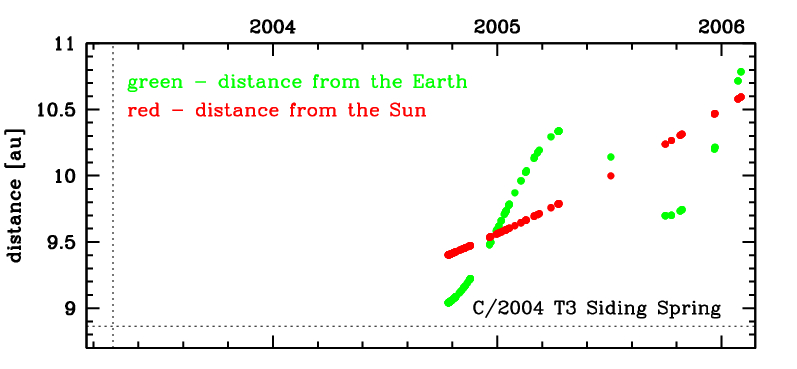C/2004 T3 Siding Spring
more info
C/2004 T3 was discovered by Robert H. McNaught on images from the Siding Spring 0.5m Uppsala Schmidt on 12 October 2004. Next days, its cometary apperance was confirmed by observers [IAUC 8421, 2004 October 21]. At the moment of discovery, it was 1.5 yr after its perihelion passage (see figure).
This comet made its closest approach to the Earth on 19 July 2003 (8.611 au), three months after perihelion.
Solution given here is based on data spanning over 1.3 yr in a range of heliocentric distances from 9.40 au to 10.6 au.
This Oort spike comet suffers slight planetary perturbations during its passage through the planetary system.
See also Królikowska 2014 and Królikowska and Dybczyński 2017.
This comet made its closest approach to the Earth on 19 July 2003 (8.611 au), three months after perihelion.
Solution given here is based on data spanning over 1.3 yr in a range of heliocentric distances from 9.40 au to 10.6 au.
This Oort spike comet suffers slight planetary perturbations during its passage through the planetary system.
See also Królikowska 2014 and Królikowska and Dybczyński 2017.
| solution description | ||
|---|---|---|
| number of observations | 109 | |
| data interval | 2004 10 12 – 2006 01 31 | |
| data type | observed only after perihelion (POST) | |
| data arc selection | entire data set (STD) | |
| range of heliocentric distances | 9.4 au – 10.6au | |
| detectability of NG effects in the comet's motion | NG effects not determinable | |
| type of model of motion | GR - gravitational orbit | |
| data weighting | YES | |
| number of residuals | 209 | |
| RMS [arcseconds] | 0.44 | |
| orbit quality class | 1a | |
| orbital elements (heliocentric ecliptic J2000) | ||
|---|---|---|
| Epoch | 2003 05 01 | |
| perihelion date | 2003 04 15.23457200 | ± 0.02476300 |
| perihelion distance [au] | 8.86450665 | ± 0.00008577 |
| eccentricity | 0.99749028 | ± 0.00003702 |
| argument of perihelion [°] | 259.677146 | ± 0.001656 |
| ascending node [°] | 50.392989 | ± 0.000134 |
| inclination [°] | 71.959969 | ± 0.00005 |
| reciprocal semi-major axis [10-6 au-1] | 283.12 | ± 4.17 |
